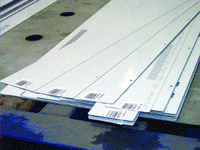 Kone is one of the worlds leading lift manufacturers with 35,000 workers and a global network of branches. Based in Italy, where it is market leader, the company recently implemented an identification system from Intermec and AIDC specialist BPS which has minimised production errors and reduced wastage of materials.
Kone is one of the worlds leading lift manufacturers with 35,000 workers and a global network of branches. Based in Italy, where it is market leader, the company recently implemented an identification system from Intermec and AIDC specialist BPS which has minimised production errors and reduced wastage of materials.
Kones Pero-based plant is dedicated to the production of lift cabs and doors, while it also has further offices all over Italy offering after-sales services and maintenance.
Long Lead Times and Excessive Waste
At Pero lifts are exclusively manufactured to order and there are no standard panels. Such targeted production requires special levels of care throughout the process and, before the BPS and Intermec identification system was introduced, Kone had to cope with a variety of problems.
To avoid confusion during assembly, the production line used to be run for individual orders. This system proved extremely wasteful in terms of materials, because it was impossible to optimise metal sheets to use them in full. A system needed to be developed that would enable several orders to be worked on at once.
A Code for Each Part
With the help of BPS technicians, the company installed a device for automatic labelling on its punching machine, linked to an Intermec 3400 D printer. After inserting the metal sheet, the final part is cut and formed. This is immediately identified using a label which is stuck on with special metal glues and remains firmly in place through every phase of production until delivery.
 Roberto Casanova, Kones Electrical Maintenance Supervisor states, Before introducing this system it wasnt easy to recognise panels during assembly because, even if they were for different orders, the individual parts could look very similar and might only differ by a few centimetres.
Roberto Casanova, Kones Electrical Maintenance Supervisor states, Before introducing this system it wasnt easy to recognise panels during assembly because, even if they were for different orders, the individual parts could look very similar and might only differ by a few centimetres.
Roberto Brizza, Head of Automatic Identification at BPS continues With this system we apply a barcode at the earliest phase of processing. As a result we can now safely say that the instances of incorrect identification have been practically eliminated.
Better Use of Materials
Metal sheets at Kone can now be used for up to five panels. Before introducing automatic identification, the company was limited to working on a single production order at a time because there was always the risk of confusing the parts. Today it is possible to manufacture panels from different orders at the same time.
We can use a metal sheet to produce three panels from one order and two from another, continues Casanova, because automatic labelling means there is no risk of muddling up the parts. This system has enabled us to optimise the use of the metal sheet and the waste is really minimal.
Lower Costs and Improved Quality
In economic terms, not only has Kone been able to reduce waste, it has also been able to enhance quality. The risk of allotting the wrong part to a particular order could create enormous problems on site, because the error was only detected during assembly, resulting in the interruption of work and delays waiting for the new part all of which raised costs.
The new technology was introduced in stages: the first machine was introduced six years ago and there are now five labelling machines: four of which are used for sheet metal production and one in the doors shop. Today Kones entire production is covered by this system and labelling also helps operators during the assembly phase - parts are packaged by order and the waybill can only be printed when all the parts have been detected by the scanner.
The implementation of this technology was painless, concludes Casanova, because it only brought benefits for the users. Automatic identification is a tremendous help and our workers are now able to work with greater peace of mind.

Add a Comment
No messages on this article yet